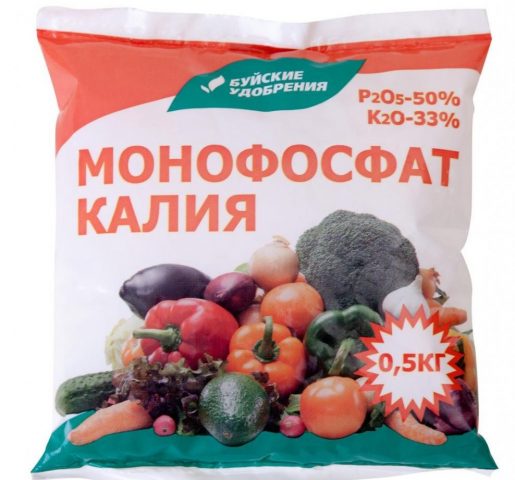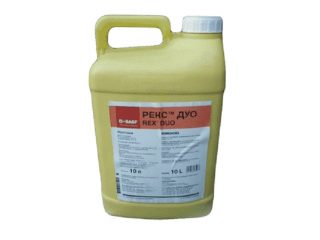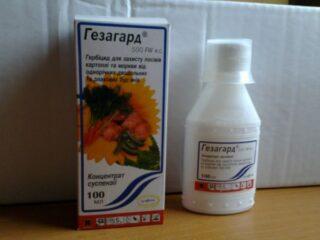Content
- 1 Composition and properties of the drug
- 2 Advantages and disadvantages
- 3 Instructions for using potassium monophosphate for tomatoes
- 4 Compatibility with other fertilizers
- 5 How to replace potassium monophosphate for tomatoes
- 6 Security measures
- 7 Conclusion
- 8 Reviews on the use of potassium monophosphate for tomatoes
Experienced gardeners know that without the use of fertilizers it will not be possible to grow strong seedlings and a good harvest of tomatoes. However, when using them, it must be taken into account that this crop at any stage of growth needs a large amount of phosphorus and potassium. After all, these components contribute to the uniform growth of the above-ground parts and root system, abundant flowering, and fruiting. Therefore, potassium monophosphate fertilizer is of particular importance for tomato seedlings and adult bushes. But for it to bring maximum benefit, you need to use it correctly to feed the crop.

Potassium monophosphate contains nutritional components in an accessible form for plants
Composition and properties of the drug
This fertilizer is available in the form of powder and granules. The product is sold in various packaging, which allows you to purchase the required quantity for both private and industrial use.The fertilizer has a beige or light brown tint and is odorless.
The chemical formula of this agrochemical is KH2PO4; in the special nomenclature it has the name dihydroorthophosphate (monopotassium salt of orthophosphoric acid). As a percentage, the fertilizer contains 52% phosphorus and 34% potassium.
Potassium monophosphate does not accumulate in the soil and quickly disintegrates. Therefore, it is recommended to use it for feeding tomatoes only in the form of nutrient solutions. The fertilizer is hygroscopic, therefore, if stored in conditions of high humidity, it loses its effectiveness. Potassium monophosphate shows maximum effectiveness in moderately warm and humid weather. In greenhouses and greenhouses it can be used with good lighting and regular ventilation.
Main properties of the agrochemical:
- dissolves well in water;
- safe for humans and the environment;
- acidifies the soil;
- gives results only with a sufficient amount of nitrogen in the soil.
Advantages and disadvantages
This fertilizer has a number of advantages, which explains its increased popularity among experienced and novice gardeners. However, monopotassium phosphate also has certain disadvantages that need to be taken into account.

This mineral fertilizer prevents tomato seedlings from stretching
Main advantages:
- Can be used at any stage of plant development;
- suitable for root and foliar feeding;
- provides tomatoes with the necessary nutritional components;
- increases the yield and quality of fruits;
- provides abundant flowering;
- prevents shedding of the ovary;
- strengthens the resistance of seedlings;
- improves taste;
- has a beneficial effect on beneficial soil microflora.
Flaws:
- feeds not only garden crops, but also weeds;
- cannot be used dry;
- incompatible with calcium and magnesium;
- requires special storage conditions;
- causes excessive tillering;
- during prolonged rains it is quickly washed out of the soil.
Instructions for using potassium monophosphate for tomatoes
Feeding tomatoes with potassium monophosphate is recommended at the stage of growing seedlings, as well as during flowering and fruiting of the crop. It can be carried out by watering plants at the roots and spraying them on the leaves. However, depending on the method chosen, it is necessary to follow the instructions for using potassium monophosphate in order to avoid serious mistakes.
Feeding tomatoes with potassium monophosphate at the root
Fertilizer for root feeding needs to be applied several times per season. It is recommended to carry out the procedure for the first time 7-10 days after planting the seedlings in a permanent place. An additional sign for fertilizing is the appearance of a new leaf, which indicates the rooting of the seedlings. At this stage, it is necessary to use fertilizer at the rate of 7-10 g per 10 liters of water. The recommended dosage of the nutrient solution is 3-4 liters per 1 square meter. m area. It is recommended to apply fertilizer to moist soil.
The second feeding of tomatoes is necessary during the flowering period, which will ensure the formation of new clusters with ovaries. This time the product should be diluted at the rate of 10 g per 10 liters of water and used for each square meter. m 4 liters of nutrient solution.
The third root feeding of tomatoes is recommended during fruiting.During this period, fertilizer must be applied in a proportion of 15 g per 10 liters of water, pouring 6 liters of nutrient solution per square meter. m.
Foliar feeding
This type of feeding is recommended when there are enough leaves on tomatoes. Therefore, it is recommended to carry it out for the first time when the seedlings have at least three new leaves after transplanting to a permanent place. According to the instructions for use, monopotassium phosphate for foliar feeding of tomatoes should be diluted at the rate of 2 g per 10 liters of water and mixed thoroughly. It is recommended to spray the seedlings with the solution in the early morning or late evening, which will allow the leaves to evenly absorb the liquid. In the future, you can apply this fertilizer two weeks after the previous one, adhering to a similar dosage.
Foliar feeding should be used as emergency aid for tomatoes after prolonged rains. This will allow the seedlings to quickly receive the necessary nutritional components.

Foliar feeding is unable to replace root feeding
Feeding tomato seedlings with potassium monophosphate
This product can also be used at the initial stage of tomato development. In this case, feeding tomato seedlings with potassium monophosphate helps prevent the seedlings from stretching. It is necessary to dissolve 10 g of the drug in 10 liters of water and use the resulting liquid for watering plants.You can feed tomato seedlings with potassium monophosphate for the first time ten days after picking. In the future, it is recommended to repeat it every two weeks to ensure uniform development of seedlings.
Compatibility with other fertilizers
You can use potassium monophosphate not only on its own to feed tomatoes, but also in combination with other fertilizers. When using a product with nitrogen, the root system of plants is strengthened, and the growth of new shoots and brushes is activated. However, fertilizing should be done with a break of ten days. Moreover, nitrogen should be added after potassium monophosphate.
However, it is worth considering that the product cannot be combined with magnesium and calcium. In this case, it is necessary to take a break between feedings of two weeks to avoid negative consequences.
How to replace potassium monophosphate for tomatoes
The main advantage of the drug is that it contains phosphorus in an easily accessible form for plants. Therefore, if it is not at hand, replacing it is not so easy. After all, superphosphate, known to all gardeners, is characterized by a delayed nutritional effect. Therefore, you need to add it to the soil in the fall or prepare a special extract based on it, which is not always convenient.
The only replacement option may be Pekacid fertilizer. The product contains up to 60% phosphorus and 20% potassium. However, this fertilizer has an increased cost.
Security measures
When working with potassium monophosphate, precautions must be taken. According to the instructions, before preparing a nutrient solution for tomatoes, you need to put on gloves, goggles and a respirator.
It is recommended to carry out the procedure in calm weather to eliminate the possibility of contact with open areas of the body. The prepared nutrient solution must be used immediately, as it loses its beneficial properties during storage. Therefore, it is not recommended to do it for future use.

The fertilizer should be diluted in settled water at a temperature of +15-25 °C
When using the drug, the indicated dosages must be strictly observed. To measure the drug correctly, it should be taken into account that a teaspoon contains 4 g of fertilizer, and a tablespoon contains 10 g.
While using the product, it is forbidden to drink, smoke, or eat. If fertilizer gets on your skin or mucous membranes, wash the affected areas with plenty of water.
Conclusion
Potassium monophosphate for tomato seedlings is considered one of the best fertilizers according to experienced gardeners. Therefore, its regular use makes it possible to get a good harvest for your work. However, in order for this product to really bring maximum benefit to tomatoes, the recommended timing and dosage must be followed.
Reviews on the use of potassium monophosphate for tomatoes








